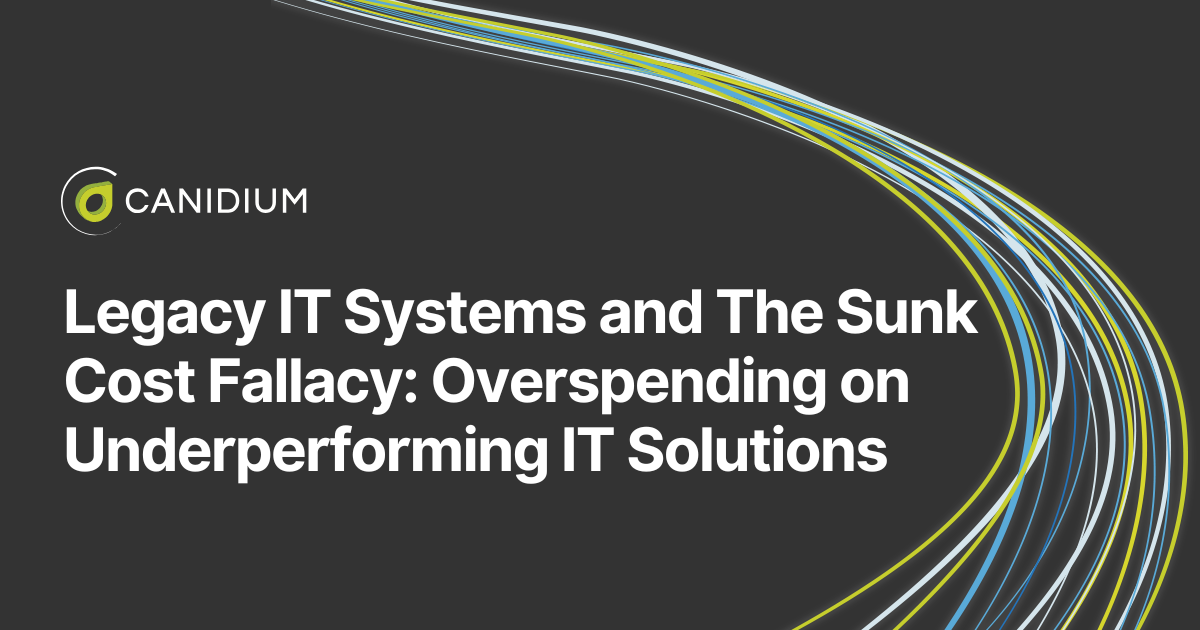Legacy systems rack up a $40,000 annual bill for the average IT department in simple system maintenance costs. At the same time, 75% of technology professionals are concerned by the security vulnerabilities in legacy IT systems, and 44% report difficulty integrating new solutions with legacy applications—leading to increased annual IT budget requirements.
Simply put, if you are operating on a legacy IT system, you are bleeding money to maintain outdated technologies that often offer subpar functionality, compatibility issues, and potentially severe security risks. Depending on how core your legacy technology is to daily operations, the lack of modern features in these systems may even hamper entire departments within your organization.
Over time, companies operating on legacy applications and systems will inevitably fall behind competitors. The efficiency gains of modern technologies are too great to manually keep up with. However, investing in modern applications and system upgrades can be costly and time-consuming. So, is it worth it?
In this article, our experts weigh the pros and cons of maintaining legacy IT systems vs. investing in modern systems.
What is a Legacy IT System?
A legacy system is any outdated technology still in use. Outdated software applications, widely unused programming languages within tech stacks, files formats with compatibility issues, legacy hardware solutions, or digital infrastructure that is no longer actively supported or developed are all types of legacy systems.
As you might expect, legacy systems typically have been in operation for many years. Moreover, legacy infrastructure may not be obsolete; you may still use older technology in daily business operations with limited efficacy. However, systems that fit the definition of "legacy" present challenges such as limited scalability, lack of modern features, and difficulty integrating with modern IT environments. Because of these challenges, digital transformation is worth it for most organizations.
The Sunk Cost Fallacy: Why Legacy Systems Are Still Used
It costs an estimated $1.14 trillion annually to keep legacy systems running. Imagine how much potential innovation, revenue, and progress is lost because of slow, outdated systems. So, why do companies hang on to legacy applications?
Business continuity is one of the core reasons legacy systems tend to linger. For many companies, these technologies continue to serve their function just as well as when they were initially implemented. Consequently, upgrading to newer systems is easy to overlook when setting annual investment priorities and goals. Furthermore, your workforce is used to navigating your legacy software and might resist learning to leverage newer technology.
If you have a legacy system, there may be unique reasons you continue to use it. The existing solution may be critical to your daily functions and business needs, or your existing projects might require them. Legacy systems are often still functional; yet they offer less at a higher cost than more modern solutions.
Above all else, there is one major reason why companies don't update their outdated systems: the sunk cost fallacy, or the mistaken belief that you should continue investing in a decision or project because you've already invested time, money, or effort into it. If you have been using the same system for years or even decades, you have likely invested tens of thousands, if not millions, of dollars in your existing infrastructure. Understanding that an investment you have sunk that much money and effort into is no longer worthwhile can be hard to swallow.
The Lawn vs. the Landscape
Imagine a homeowner who spends every weekend mowing their lawn. The mower is old; the grass is uneven, so the task takes up significant time each weekend. On the other side of the street, a neighbor hires a landscaping company to bring in drought-tolerant plants, smart irrigation, and a low-maintenance design. While the upfront cost is higher, the neighbor is interested in the long-term efficiency gains. Still, the homeowner resists, making the same investment as their neighbor, saying, "I've already spent so much time and money on this lawn; it would be a waste to give it all up." As a result, while the neighbor relaxes every weekend, the homeowner continues to toil in the hot sun every week for years to come. This is the sunk cost fallacy: allowing past investments to justify continuing a less efficient path rather than making a smarter decision based on future value.
The same logic often plays out in business, particularly with legacy IT systems. A company may be stuck maintaining outdated hardware or legacy software systems. This legacy tech could be rife with security breaches, unsupportive of critical business functions, or hampered by legacy code. Yet, when presented with the opportunity to gain a competitive edge through digital transformation, perhaps through cloud migration, automation, or a new platform, business leaders might say, "We've already spent millions on this system. We can't afford to invest in an overhaul now." But again, this is the sunk cost fallacy. The company would continue to overspend on an underperforming legacy solution, eventually falling behind in terms of operational capacity and efficiency. The money and effort already spent are gone; they shouldn't influence whether the company chooses a better solution going forward.
The Case for Legacy System Modernization: 6 Problems With Legacy IT Systems
Imagine pitting the world's first general-purpose computer, which is more than 75 years old and large enough to fill an entire room, against an average modern laptop. Which do you think is more performant? Which would cost you more to maintain? This is an extreme example, but the principle is the same for every legacy IT system. Outdated technology becomes obsolete as newer, better solutions arise.
Here are six core problems legacy IT systems create for today's organizations:
.png?width=1920&height=1080&name=Subheading%20(6).png)
High Maintenance Costs
Legacy systems often require ongoing patching, manual fixes, and specialized support staff to keep them running. These costs accumulate over time, eating into IT budgets and offering diminishing returns as the system ages.
Over time, legacy IT systems tend to grow more expensive while offering less value with each passing year. The longer you wait to invest, the more money you will burn on basic maintenance each year.
Limited Integration and Interoperability
Older platforms were not built to connect with today's digital ecosystem. In a survey of IT leaders, one-third of respondents said up to 25% of their legacy systems cannot support AI tools and workloads. Integrating them with modern applications, whether for analytics, automation, or customer engagement, requires custom code or middleware, which adds complexity and potentially slows down your entire system.
Most of the time, legacy IT systems were designed to operate in silos. They don't have modern integration capabilities such as RESTful APIs or webhooks. As a result, connecting these systems with cloud platforms, analytics tools, or automation software requires extensive custom development, creating bottlenecks and reducing your overall system agility.
Security Risks and Compliance Challenges
Unsupported software and outdated security protocols leave legacy systems exposed to costly cyber threats. As of February 2024, the global average cost per data breach amounted to 4.88 million U.S. dollars, an increase from 4.45 million U.S. dollars in the previous year.
Legacy technology often falls short of modern data privacy and industry compliance requirements, increasing your risk of fines and reputational damage. Older systems may no longer receive security patches or vendor support, exposing them to vulnerabilities such as outdated encryption standards, unsupported operating systems, and lack of compliance with modern data protection regulations.
Scalability and Performance Bottlenecks
As businesses grow, legacy systems struggle to scale. Whether it's user volume, transaction throughput, or data storage, outdated infrastructure can't keep pace with modern demands, resulting in slow performance and operational bottlenecks.
Legacy systems can also struggle to support increased workloads, additional users, or new business models. Their interfaces may be outdated, unintuitive, or designed only for desktop use, leading to frustration, training overhead, and reduced productivity. At the same time, mobile access and personalization are often non-existent.
Limited Workforce Expertise
Many legacy systems were developed in-house using older technologies or programming languages that are no longer widely used (e.g., COBOL, VB6, ColdFusion). Consequently, as new professionals with expertise in modern solutions begin to dominate the workforce, finding employees or contractors to support or modify these systems becomes increasingly difficult and expensive.
Over time, your company will experience knowledge loss due to retirements or turnover. If you can't replace these employees, your entire system—and the business processes it supports—are at risk.
Poor User Experience and Productivity Loss
Legacy applications typically have outdated, clunky interfaces that frustrate users and require significant training. This reduces efficiency and lowers employee satisfaction, especially when compared to the intuitive, mobile-ready tools users expect today.
At the same time, you will need more employees to perform the same workload your competitors are managing with little overhead. Your teams will be overburdened with tasks that automation could manage, likely with greater accuracy and efficiency.
What Modern IT Systems Look Like
In contrast to the potential issues of common legacy systems, modern software is capable of serving the most essential functions modern businesses need. From cloud computing to APIs, modern IT infrastructure can offer much more than the typical legacy system.
Here are some of the common attributes of modern solutions:
Cloud-Native Platforms With Frequent Updates and Security Patches
Modern systems are built for the cloud, offering continuous delivery of new features, performance enhancements, and security updates without the need for disruptive upgrades. This ensures that businesses stay current with the latest technology standards while also reducing their operational overhead.
API-first Application Architecture for Seamless Data Exchange
Contemporary platforms are designed with integration in mind. They expose standardized APIs and connectors, making plugging into other enterprise systems, third-party applications, or automation tools easier. This enables real-time data flows, better collaboration, and faster operations.
User-Friendly Interfaces and Self-Service Capabilities
Modern platforms focus heavily on usability, offering clean, responsive interfaces optimized for desktop, tablet, and mobile. They often include self-service features like configurable dashboards, drag-and-drop reporting, and workflow builders, empowering end-users to get what they need without waiting on IT while simultaneously freeing up your technical professionals' time.
Reduced Technical Debt and Total Cost of Ownership
Modern systems reduce the hidden costs associated with patching, support, and downtime by eliminating outdated infrastructure and hard-to-maintain codebases. As a result, technical resources can be reallocated toward strategic initiatives instead of maintenance and firefighting.
Legacy IT Systems and The Sunk Cost Fallacy
Legacy IT systems often continue to drain company resources despite their outdated nature and growing inefficiencies. As businesses maintain these systems, they tend to focus on sunk costs—the money, time, and effort already invested—instead of considering the future costs and opportunities of modernizing. This mindset traps organizations into spending more on systems that are inherently costly, insecure, and unable to scale with growing business needs. The continuing reliance on these outdated systems hinders innovation, increases operational complexity, and exposes businesses to greater security risks.
Modern IT solutions, with cloud-native platforms, API-first architectures, and improved user interfaces, offer significant performance, security, and cost-efficiency benefits. Organizations can streamline operations, reduce technical debt, and foster innovation by shifting focus away from sunk investments and embracing new technologies. Transitioning to more modern systems not only improves day-to-day operations but also positions businesses to remain competitive in an ever-evolving digital landscape. Ultimately, implementing new technology is an investment in the future, one that can yield both immediate benefits and long-term competitive advantages, outweighing the costs of continuing to prop up legacy systems.







